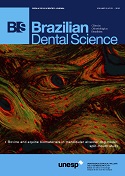Bovine and equine biomaterials in mandibular alveolar dog model: Split-mouth study
DOI:
https://doi.org/10.14295/bds.2016.v19i3.1291Abstract
A predictable rehabilitation of severely atrophied alveolar ridge defects still remains a matter of concern in implant dentistry. Objective: The aim of this study was to compare histologically biomaterials of bovine (Genox®) and equine (Bio-Gen®) origin associated or not to platelet-rich plasma (PRP), analyzing bone maturity, amount of mature (type I) and immature (type III) collagen present at sixty and ninety days in post-extraction alveolus. Materials and Methods: Four Beagle dogs were used from which the six mandibular premolars were extracted. The alveolus contained respectively: right side, Bio-Gen ® (group B), preserved the clot (group C), Genox ® (group G); left side, Bio-Gen ® + PRP group (BP), Clot + PRP (group CP) and Genox ® + PRP (group GP). After sixty and ninety days, two dogs were sacrificed at each date and the pieces were histologically processed and stained with picrosirius red, a specific stain for analysis of different types of collagen. Results: Comparisons of the averages of mature collagen at 60 days indicated significant differences between Group G when compared to Groups C and B. The biomaterial of bovine origin demonstrated higher amounts of mature collagen in 90 days while the biomaterial of equine origin had a higher average of immature collagen in 90 days. Conclusion: Groups associated to PRP were effective in the production of mature and immature collagen. Genox® associated with PRP demonstrated a more advanced stage of bone regeneration presenting as an alternative to fill post-extraction alveolus.
Downloads
Downloads
Published
How to Cite
Issue
Section
License
Brazilian Dental Science uses the Creative Commons (CC-BY 4.0) license, thus preserving the integrity of articles in an open access environment. The journal allows the author to retain publishing rights without restrictions.
=================
COPYRIGHT TRANSFER AND RESPONSIBILITY STATEMENT
(PDF)
For all articles published in the BDS journal, copyright is retained by the authors. Articles are licensed under an open-access Creative Commons CC BY 4.0 license, meaning that anyone may download and read the paper for free. In addition, the article may be reused and quoted, provided that the original published version is cited. These conditions allow for maximum use and exposure of the work while ensuring that the authors receive proper credit. All metadata associated with published articles is released under the Creative Commons CC0 Universal Public Domain Dedication.
Before the submission, authors must obtain permission to reproduce any published material (figures, schemes, tables, or any extract of a text) that does not fall into the public domain or for which they do not hold the copyright. Permission should be requested by the authors from the copyright holder (usually the Publisher, please refer to the imprint of the individual publications to identify the copyright holder).
The authors hereby attest that the study is original and does not present manipulated data, fraud, or plagiarism. All names listed made a significant scientific contribution to the study, are aware of the presented data, and agree with the final version of the manuscript. They assume complete responsibility for the ethical aspects of the study.
This text must be printed and signed by all authors. The scanned version should be submitted as supplemental file during the submission process.




























